Listening comprehension strategy instruction: A review of previous studiesx
In spite of receiving minimal concern in the teaching and learning of English as
Second/ Foreign Language (ESL/ EFL); listening comprehension is one of the most
important skills in language learning (Bern, 1998; Oxford, 1993). This skill not only affects
other related academic subjects of the students such as speaking, presentation or interpreting
in English, but it also has lots of impacts on their professional practice. Being aware of the
importance of mastering this skill, the author of this study, who is also a teacher, has spent
much time reviewing literature related to methods to improve her students’ listening skills
and found that there is a need to train them how to listen effectively (Gramham &Maccaro,
2008; Vandergrift & Tafaghodtari, 2010). Listening strategy instruction has been widely
recognized as an effective way in improving learners’ listening proficiency across a range
of settings (Berne, 2004; Chamot, 1993; Vandergrift, 1997)
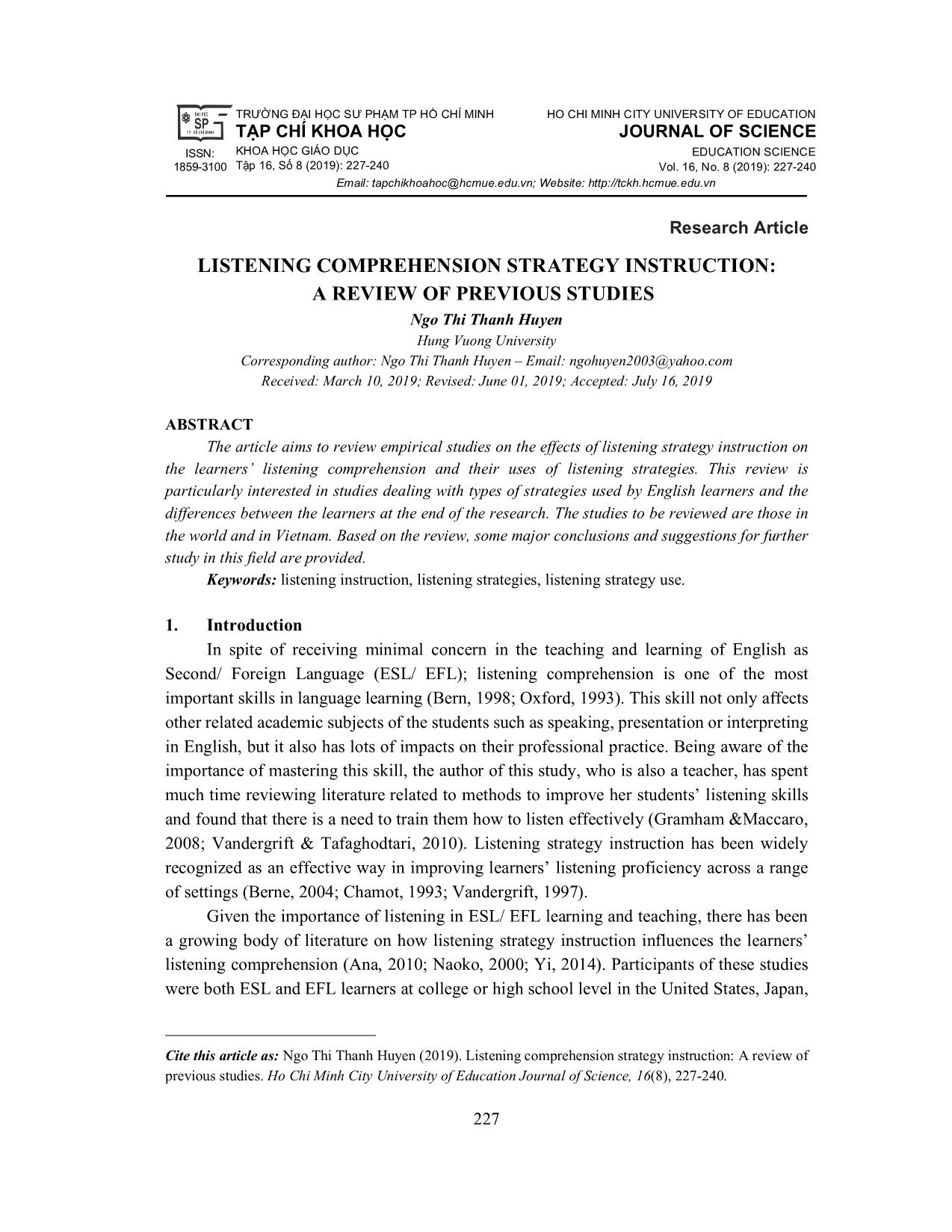
Trang 1
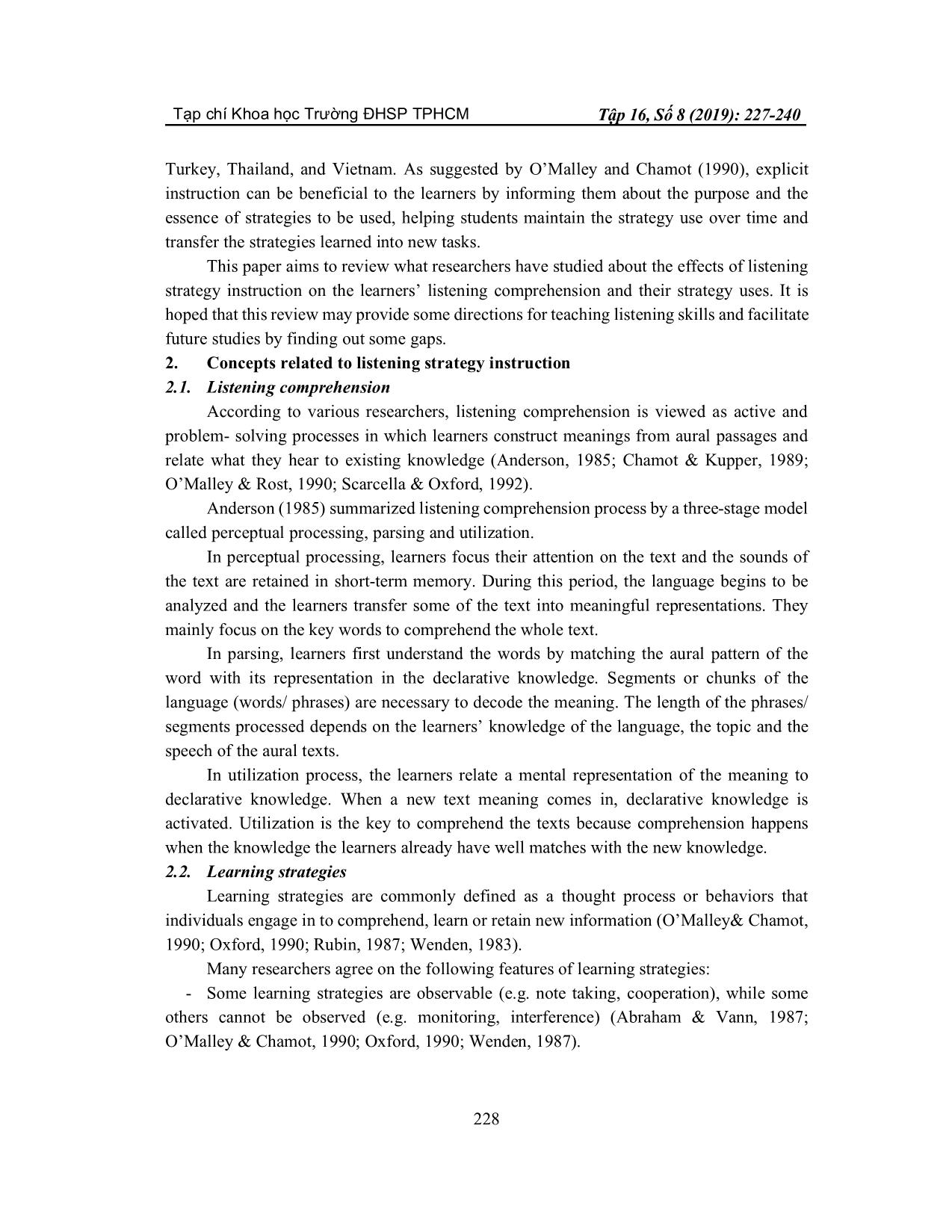
Trang 2
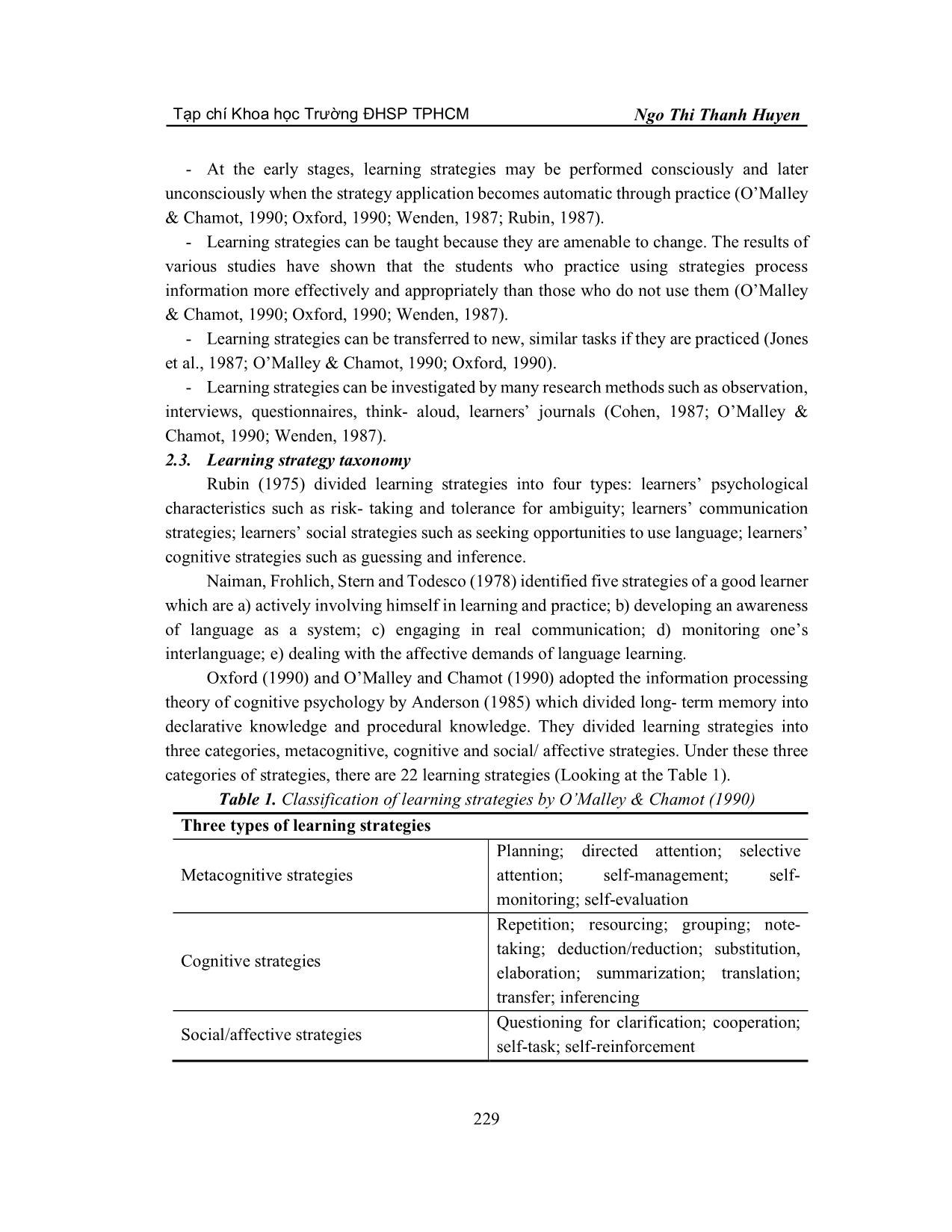
Trang 3
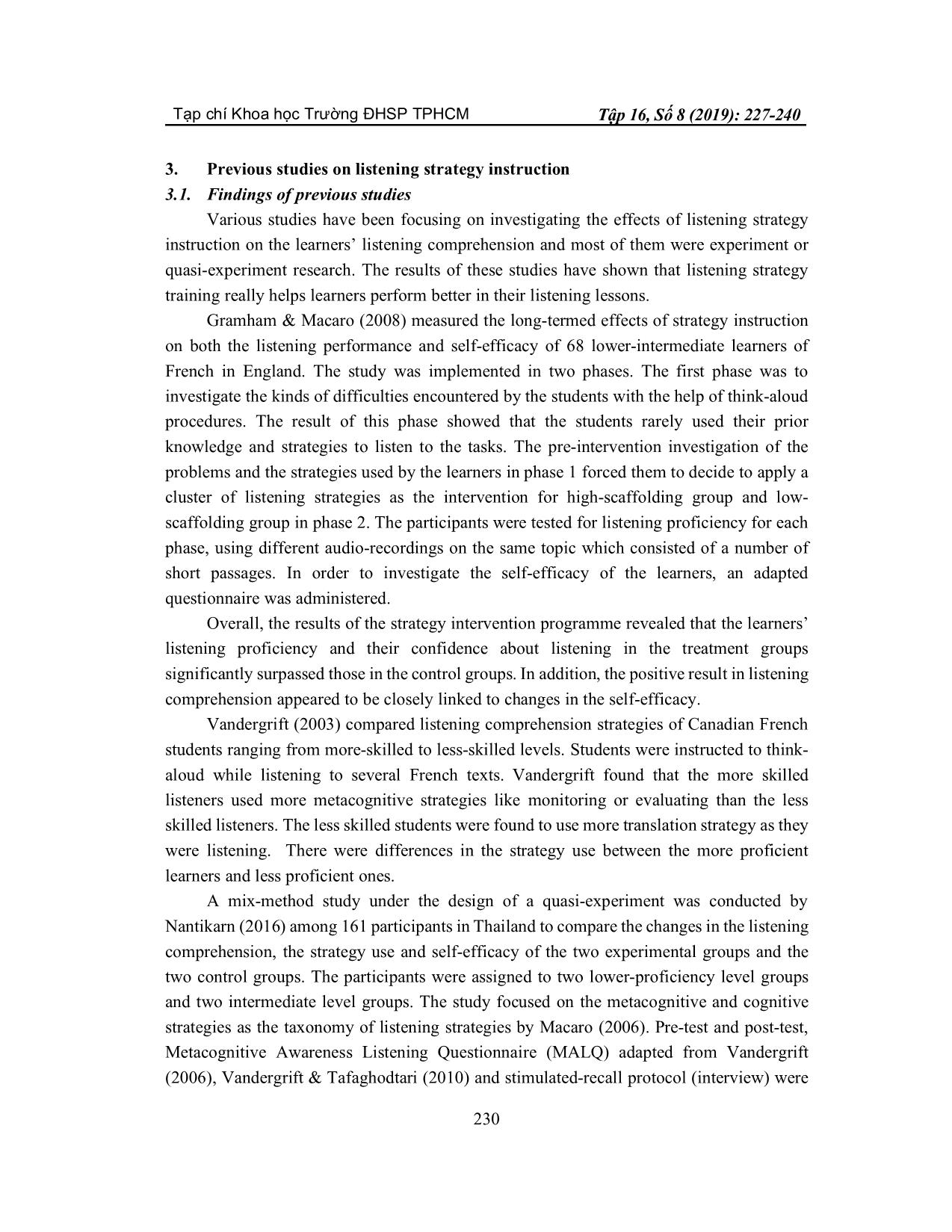
Trang 4
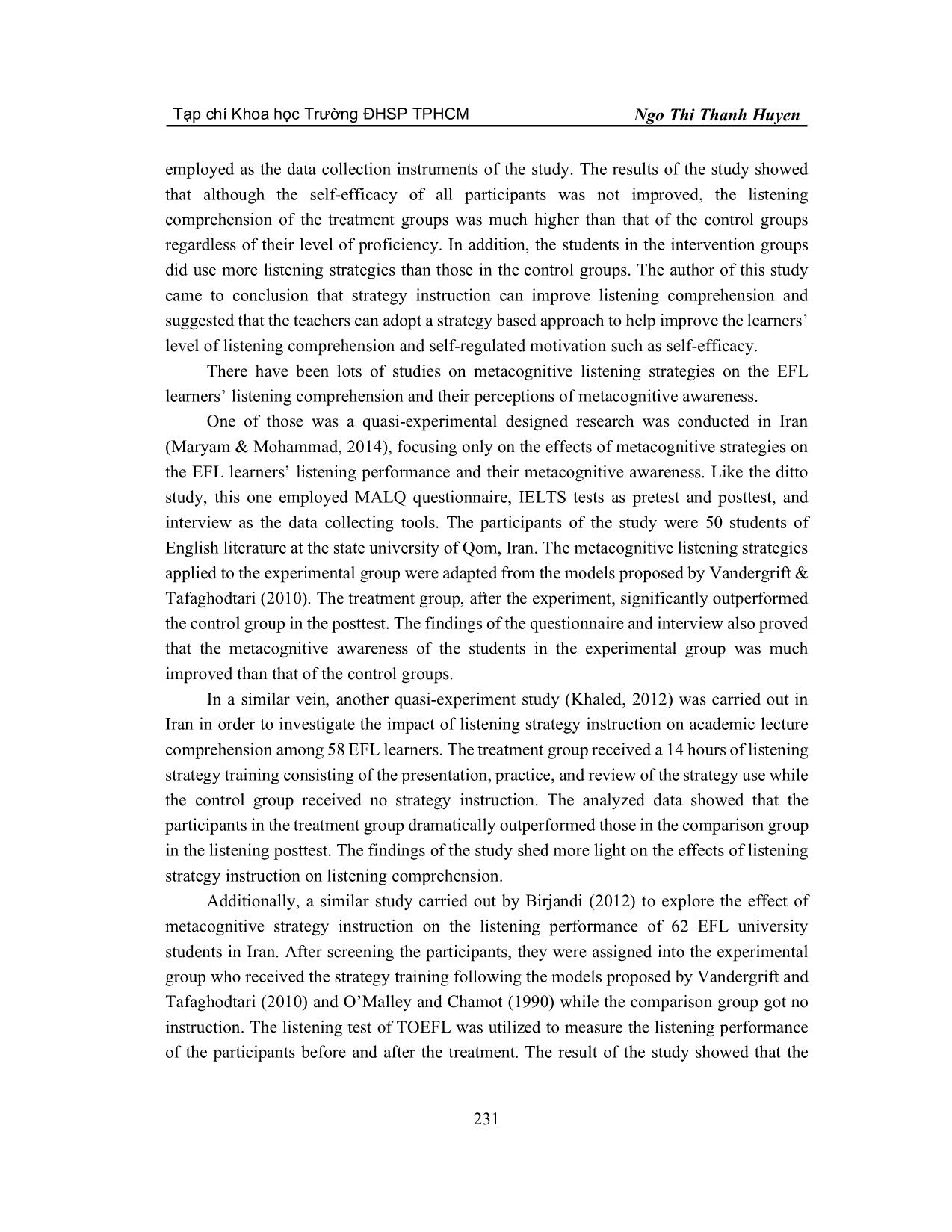
Trang 5
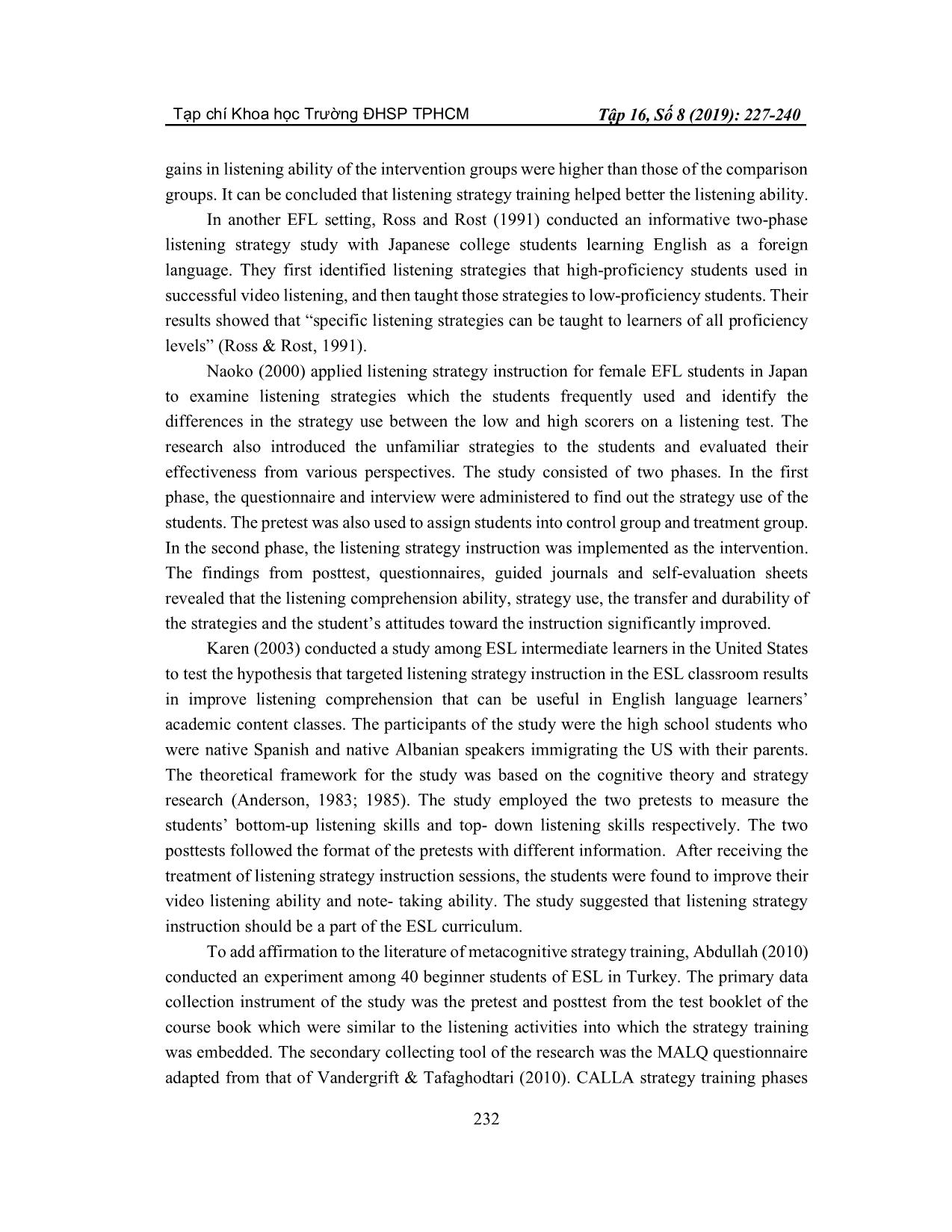
Trang 6
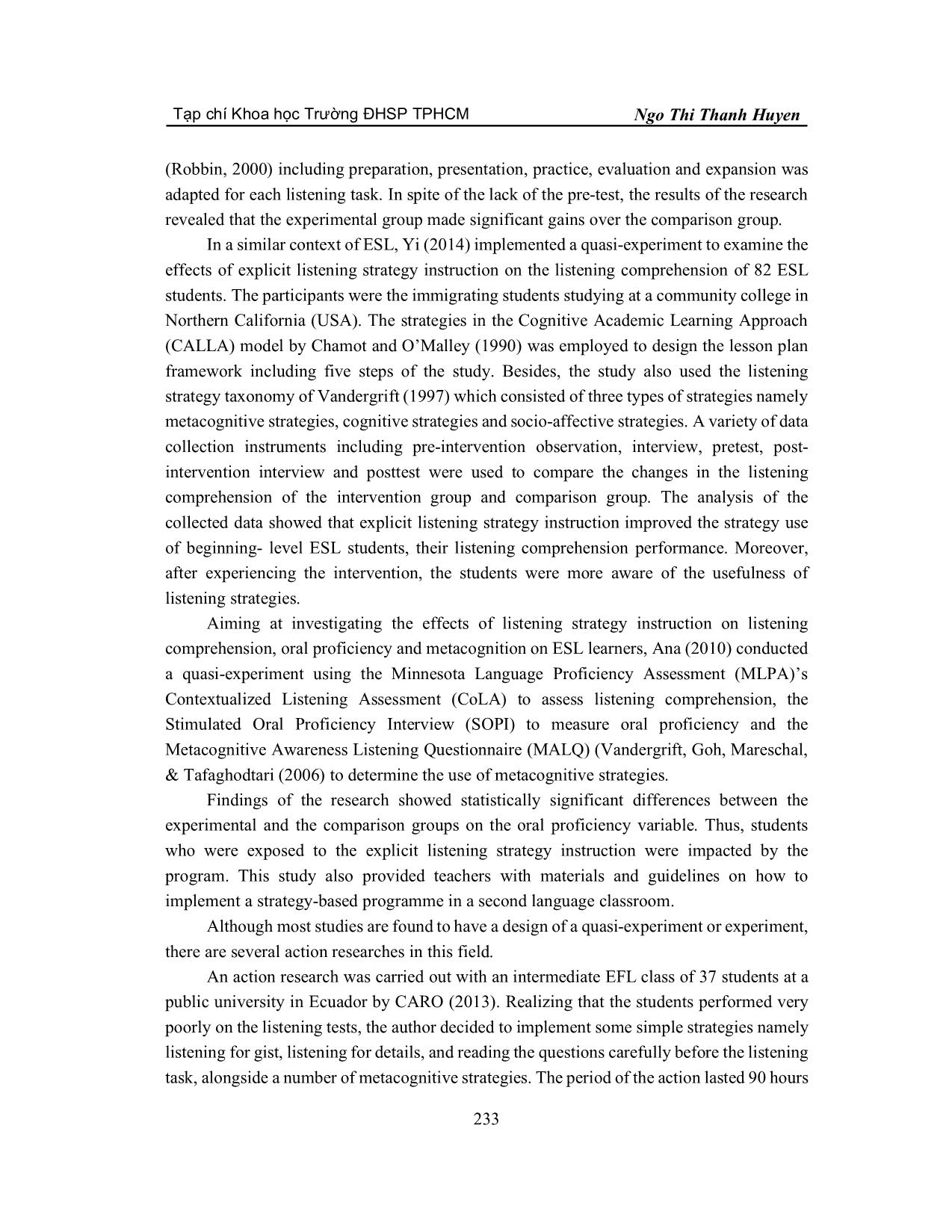
Trang 7
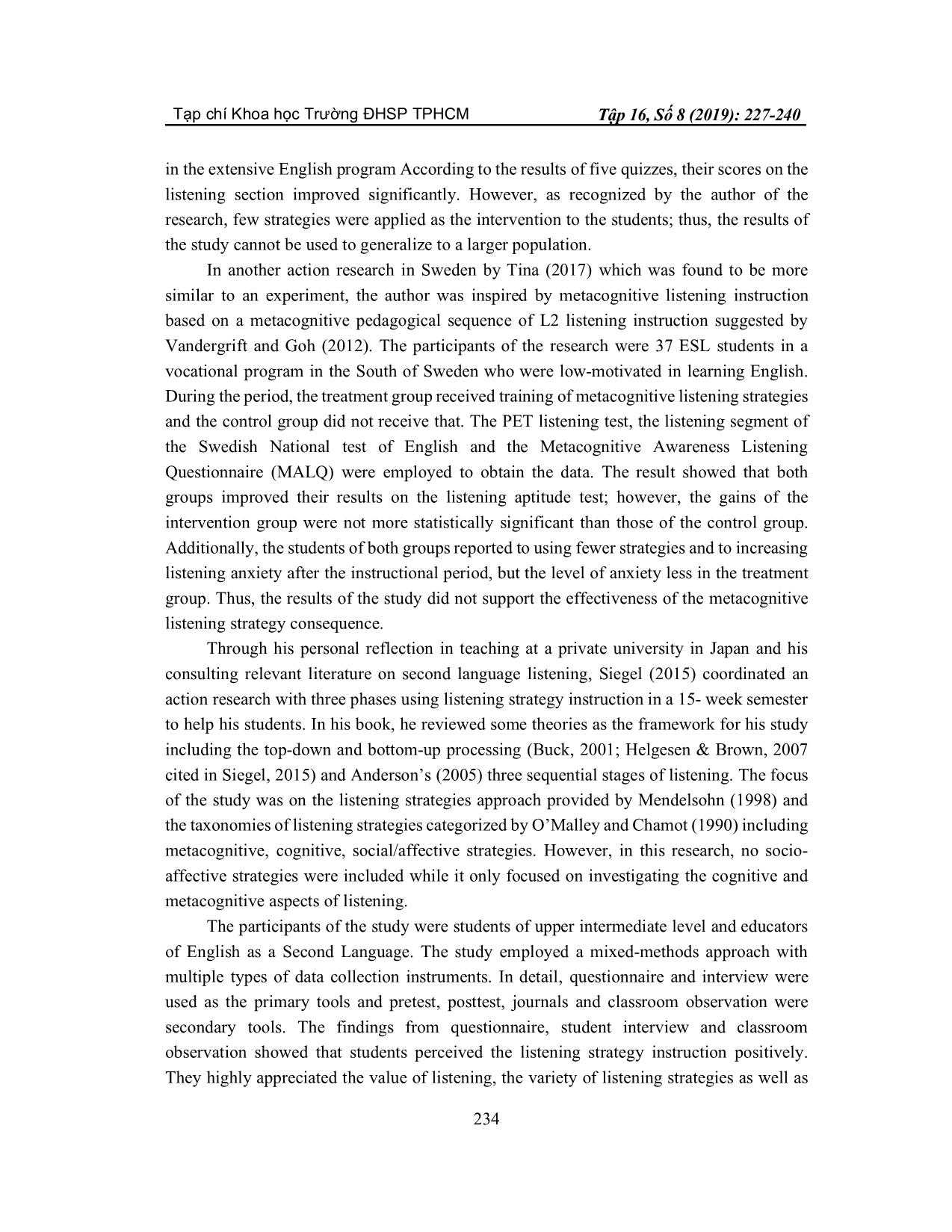
Trang 8
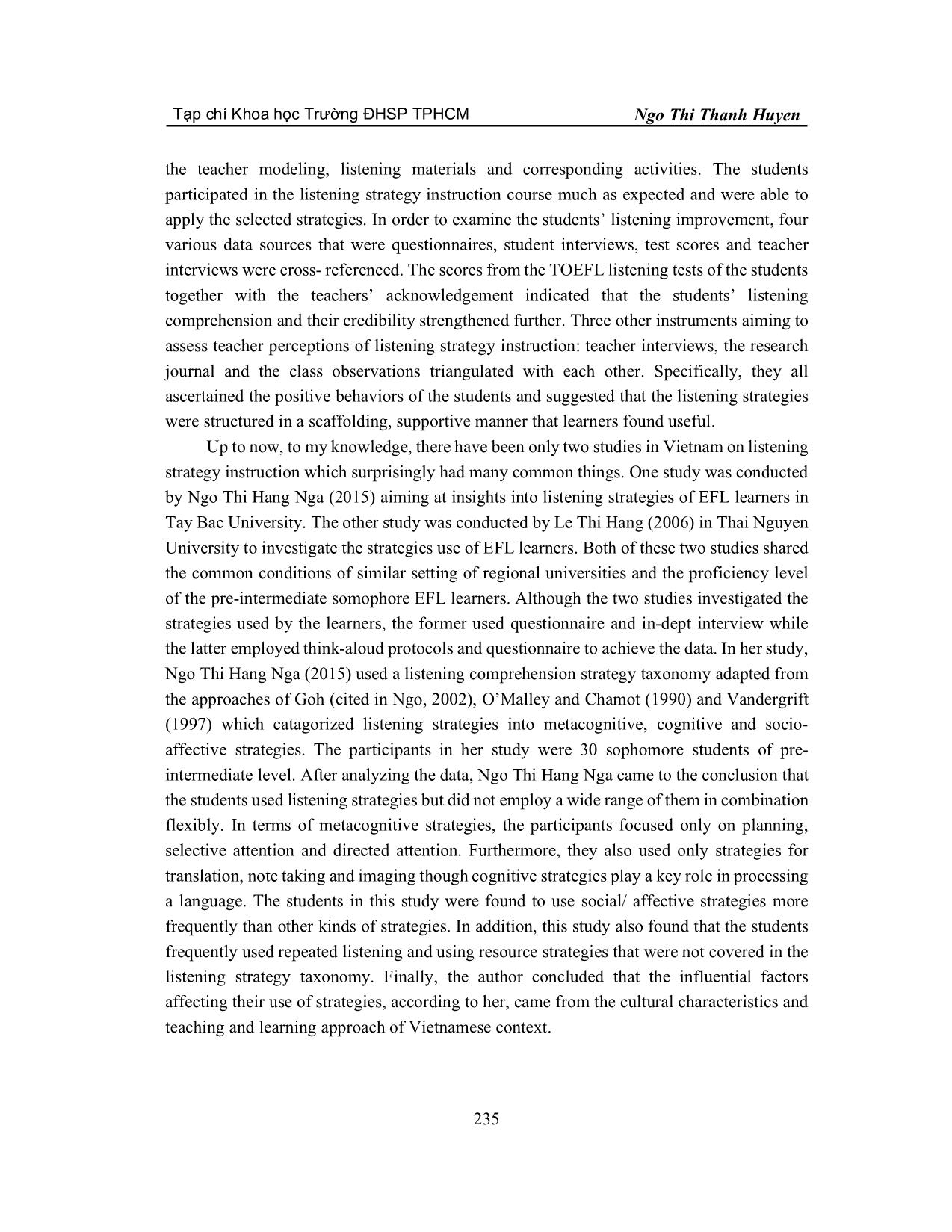
Trang 9
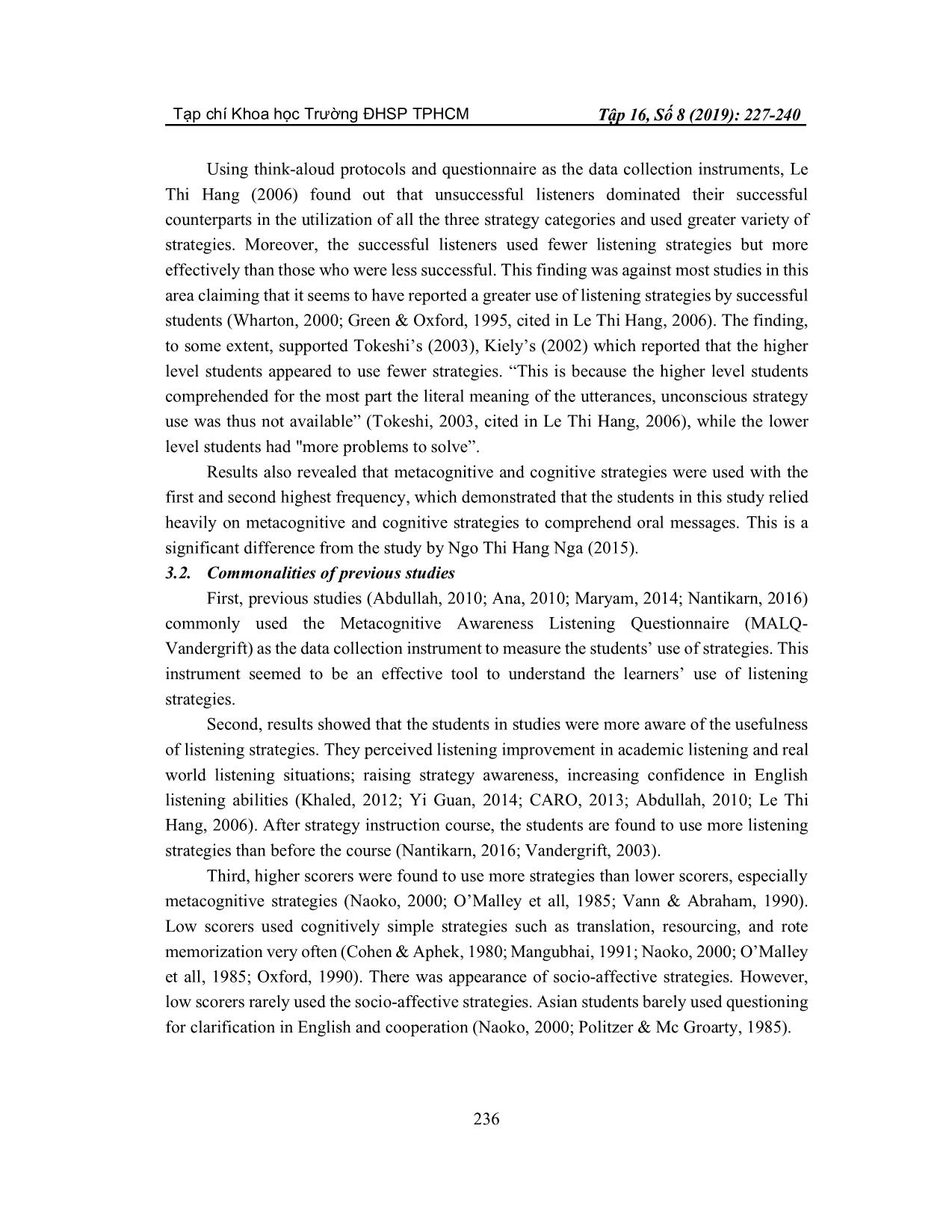
Trang 10
Tải về để xem bản đầy đủ
Tóm tắt nội dung tài liệu: Listening comprehension strategy instruction: A review of previous studiesx
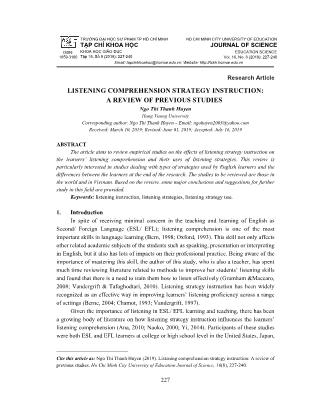
TRƯỜNG ĐẠI HỌC SƯ PHẠM TP HỒ CHÍ MINH TẠP CHÍ KHOA HỌC HO CHI MINH CITY UNIVERSITY OF EDUCATION JOURNAL OF SCIENCE ISSN: 1859-3100 KHOA HỌC GIÁO DỤC Tập 16, Số 8 (2019): 227-240 EDUCATION SCIENCE Vol. 16, No. 8 (2019): 227-240 Email: tapchikhoahoc@hcmue.edu.vn; Website: 227 Research Article LISTENING COMPREHENSION STRATEGY INSTRUCTION: A REVIEW OF PREVIOUS STUDIESx Ngo Thi Thanh Huyen Hung Vuong University Corresponding author: Ngo Thi Thanh Huyen – Email: ngohuyen2003@yahoo.com Received: March 10, 2019; Revised: June 01, 2019; Accepted: July 16, 2019 ABSTRACT The article aims to review empirical studies on the effects of listening strategy instruction on the learners’ listening comprehension and their uses of listening strategies. This review is particularly interested in studies dealing with types of strategies used by English learners and the differences between the learners at the end of the research. The studies to be reviewed are those in the world and in Vietnam. Based on the review, some major conclusions and suggestions for further study in this field are provided. Keywords: listening instruction, listening strategies, listening strategy use. 1. Introduction In spite of receiving minimal concern in the teaching and learning of English as Second/ Foreign Language (ESL/ EFL); listening comprehension is one of the most important skills in language learning (Bern, 1998; Oxford, 1993). This skill not only affects other related academic subjects of the students such as speaking, presentation or interpreting in English, but it also has lots of impacts on their professional practice. Being aware of the importance of mastering this skill, the author of this study, who is also a teacher, has spent much time reviewing literature related to methods to improve her students’ listening skills and found that there is a need to train them how to listen effectively (Gramham &Maccaro, 2008; Vandergrift & Tafaghodtari, 2010). Listening strategy instruction has been widely recognized as an effective way in improving learners’ listening proficiency across a range of settings (Berne, 2004; Chamot, 1993; Vandergrift, 1997). Given the importance of listening in ESL/ EFL learning and teaching, there has been a growing body of literature on how listening strategy instruction influences the learners’ listening comprehension (Ana, 2010; Naoko, 2000; Yi, 2014). Participants of these studies were both ESL and EFL learners at college or high school level in the United States, Japan, Cite this article as: Ngo Thi Thanh Huyen (2019). Listening comprehension strategy instruction: A review of previous studies. Ho Chi Minh City University of Education Journal of Science, 16(8), 227-240. Tạp chí Khoa học Trường ĐHSP TPHCM Tập 16, Số 8 (2019): 227-240 228 Turkey, Thailand, and Vietnam. As suggested by O’Malley and Chamot (1990), explicit instruction can be beneficial to the learners by informing them about the purpose and the essence of strategies to be used, helping students maintain the strategy use over time and transfer the strategies learned into new tasks. This paper aims to review what researchers have studied about the effects of listening strategy instruction on the learners’ listening comprehension and their strategy uses. It is hoped that this review may provide some directions for teaching listening skills and facilitate future studies by finding out some gaps. 2. Concepts related to listening strategy instruction 2.1. Listening comprehension According to various researchers, listening comprehension is viewed as active and problem- solving processes in which learners construct meanings from aural passages and relate what they hear to existing knowledge (Anderson, 1985; Chamot & Kupper, 1989; O’Malley & Rost, 1990; Scarcella & Oxford, 1992). Anderson (1985) summarized listening comprehension process by a three-stage model called perceptual processing, parsing and utilization. In perceptual processing, learners focus their attention on the text and the sounds of the text are retained in short-term memory. During this period, the language begins to be analyzed and the learners transfer some of the text into meaningful representations. They mainly focus on the key words to comprehend the whole text. In parsing, learners first understand the words by matching the aural pattern of the word with its representation in the declarative knowledge. Segments or chunks of the language (words/ phrases) are necessary to decode the meaning. The length of the phrases/ segments processed depends on the learners’ knowledge of the language, the topic and the speech of the aural texts. In utilization process, the learners relate a mental representation of the meaning to declarative knowledge. When a new text meaning comes in, declarative knowledge is activated. Utilization is the key to comprehend the texts because comprehension happens when the knowledge the learners already have well matches with the new knowledge. 2.2. Learning strategies Learning strategies are commonly defined as a thought process or behaviors that individuals engage in to comprehend, learn or retain new information (O’Malley& Chamot, 1990; Oxford, 1990; Rubin, 1987; Wenden, 1983). Many researchers agree on the following features of learning strategies: - Some learning strategies are observable (e.g. note taking, cooperation), while some others cannot be observed (e.g. monitoring, interference) (Abraham & Vann, 1987; O’Malley & Chamot, 1990; Oxford, 1990; Wenden, 1987). Tạp chí Khoa học Trường ĐHSP TPHCM Ngo Thi Thanh Huyen 229 - At the early stages, learning strategies may be performed consciously and later unconsciously when the strategy application becomes automatic through practice (O’Malley & Chamot, 1990; Oxford, 1990; Wenden, 1987; Rubin, 1987). - Learning strategies can be t ... mploy a wide range of them in combination flexibly. In terms of metacognitive strategies, the participants focused only on planning, selective attention and directed attention. Furthermore, they also used only strategies for translation, note taking and imaging though cognitive strategies play a key role in processing a language. The students in this study were found to use social/ affective strategies more frequently than other kinds of strategies. In addition, this study also found that the students frequently used repeated listening and using resource strategies that were not covered in the listening strategy taxonomy. Finally, the author concluded that the influential factors affecting their use of strategies, according to her, came from the cultural characteristics and teaching and learning approach of Vietnamese context. Tạp chí Khoa học Trường ĐHSP TPHCM Tập 16, Số 8 (2019): 227-240 236 Using think-aloud protocols and questionnaire as the data collection instruments, Le Thi Hang (2006) found out that unsuccessful listeners dominated their successful counterparts in the utilization of all the three strategy categories and used greater variety of strategies. Moreover, the successful listeners used fewer listening strategies but more effectively than those who were less successful. This finding was against most studies in this area claiming that it seems to have reported a greater use of listening strategies by successful students (Wharton, 2000; Green & Oxford, 1995, cited in Le Thi Hang, 2006). The finding, to some extent, supported Tokeshi’s (2003), Kiely’s (2002) which reported that the higher level students appeared to use fewer strategies. “This is because the higher level students comprehended for the most part the literal meaning of the utterances, unconscious strategy use was thus not available” (Tokeshi, 2003, cited in Le Thi Hang, 2006), while the lower level students had "more problems to solve”. Results also revealed that metacognitive and cognitive strategies were used with the first and second highest frequency, which demonstrated that the students in this study relied heavily on metacognitive and cognitive strategies to comprehend oral messages. This is a significant difference from the study by Ngo Thi Hang Nga (2015). 3.2. Commonalities of previous studies First, previous studies (Abdullah, 2010; Ana, 2010; Maryam, 2014; Nantikarn, 2016) commonly used the Metacognitive Awareness Listening Questionnaire (MALQ- Vandergrift) as the data collection instrument to measure the students’ use of strategies. This instrument seemed to be an effective tool to understand the learners’ use of listening strategies. Second, results showed that the students in studies were more aware of the usefulness of listening strategies. They perceived listening improvement in academic listening and real world listening situations; raising strategy awareness, increasing confidence in English listening abilities (Khaled, 2012; Yi Guan, 2014; CARO, 2013; Abdullah, 2010; Le Thi Hang, 2006). After strategy instruction course, the students are found to use more listening strategies than before the course (Nantikarn, 2016; Vandergrift, 2003). Third, higher scorers were found to use more strategies than lower scorers, especially metacognitive strategies (Naoko, 2000; O’Malley et all, 1985; Vann & Abraham, 1990). Low scorers used cognitively simple strategies such as translation, resourcing, and rote memorization very often (Cohen & Aphek, 1980; Mangubhai, 1991; Naoko, 2000; O’Malley et all, 1985; Oxford, 1990). There was appearance of socio-affective strategies. However, low scorers rarely used the socio-affective strategies. Asian students barely used questioning for clarification in English and cooperation (Naoko, 2000; Politzer & Mc Groarty, 1985). Tạp chí Khoa học Trường ĐHSP TPHCM Ngo Thi Thanh Huyen 237 Forth, there has been emergence of combined strategy use. High scorers used a combined strategy of note taking and other strategies like planning, directed attention, and elaboration. Low scorers did not use other strategies while using note taking (Naoko, 2000; Yi, 2014). Fifth, some studies discovered that there was appearance of repeated listening (listen again and again to comprehend what is heard) and using other sources (dictionary), which were not listed in the learning strategy taxonomy (Ngo Thi Hang Nga, 2015; Naoko, 2000). 3.3. Inconsistencies of previous studies First, research have shown that high-proficiency listeners used more metacognitive strategies like monitoring or evaluating than the low-proficiency listeners (Green & Oxford, 1995; Naoko, 2000; Vandergrift, 2003; Wharton, 2000). This type of listeners also got more improvement after the strategy training course (Vandergrift & Tafaghodtari, 2010). However, in his research, Nantikarn (2016) argued that the intervention participants showed improvement in strategy use regardless of their level of proficiency, and the improvement was of a similar nature across the proficiency groups. Ross and Rost (1991) also supported this point when they first identified listening strategies that high-proficiency students used in successful video listening, and then taught those strategies to low-proficiency students. Their results showed that “specific listening strategies can be taught to learners of all proficiency levels”. Second, Le Thi Hang (2006) found out that unsuccessful listeners dominated their successful counterparts in the utilization of all the three strategy categories and used greater variety of strategies. Moreover, the successful listeners used fewer listening strategies but more effectively than those who were less successful. Third, in his study, Naoko (2000) pointed out all students rarely used metacognitive strategies such as planning, directed attention, selective attention and self-evaluation. Nevertheless, in a recent research conducted in a university in Vietnam, Ngo Thi Hang Nga (2015) contradicted Naoko by concluding that among metacognitive strategies, planning, selective attention, directed attention were reported most frequently used strategies. 4. Conclusion After reviewing, comparing and contrasting the similarities and inconsistencies among previous studies, some conclusions are reached as follows: Listening strategy training is proved to be beneficial to improve learners’ listening comprehension; thus, listening strategies should be integrated into the listening curriculum. Besides the theme-based lessons, the educators should include the strategy-based ones so that the learners know how to apply the strategies in a long term. Tạp chí Khoa học Trường ĐHSP TPHCM Tập 16, Số 8 (2019): 227-240 238 There is still debate on the learners’ use of listening strategies. There is a need for more research on what kinds of listening strategies are the most effective for each kind of students. Their English proficiency levels and factors affecting their use of strategies should be taken into more consideration. Most of the studiewere conducted as quasi-experimental or experimental research while there have been very few studies on listening strategy instruction that employ design of action research. This kind of research is popular with and beneficial for the teacher researchers. In Vietnam, there have been very few studies on applying listening strategy instruction in order to help students improve their listening comprehension ability. This fact paves the way for further research in the aspect of teaching EFL listening skills. Conflict of Interest: Author have no conflict of interest to declare. REFERENCES Ana, C. Z. (2010). Effects of listening strategies instruction on listening comprehension, oral proficiency, and metacognition on second language learners (Doctoral Dissertation). Retrieved from Western Connecticut State University (USA). Abdullah, C. (2010). The effects of metacognitive strategy training on the listening performance of beginner students. Novita-ROYAL (Research on Youth and Language), 4(1), 35-50. Anderson, J. R. (2005). Cognitive psychology and its implications. (6th ed.). New York: Worth. Berne, J. E. (2004). Listening comprehension strategies: A review of the literature. Foreign Language Annals, 37(4), 25-45. CARO, J. J. (2013). Implementing Some Simple Strategies to Enhance Learners’ Listening Skills, Revista Romaneasca pentru Educatie Multimensionala, 5(1), 113-121. Chamot, A. U. (1993). Student responses to learning strategy instruction in the foreign language classroom. Foreign Language Annals, 26(3), 308-321. Graham, S., & Macaro, E. (2008). Strategy instruction in listening for lower-intermediate learners of French. Language Learning, 58(4), 747-783. Goh, C. (2002). Learners’ self-reports on comprehension and learning strategies for listening. Journal of English Language Teaching, 12(5), 45-68. Green, J. M., & Oxford, R. (1995). A closer look at learning strategies, L2 proficiency, and gender. TESOL Quarterly, 29(2), 261-297. Karen, A. C. (2003). Improving High School English Language Learners’ Second Language Listening Through Strategy Instruction. Bilingual Research Journal, 27(3), 383-408. Khaled, M. (2012). The impact of listening strategy instruction on academic lecture comprehension: A case of Iranian EFL learners. Akdeniz Language Studies Conference 2012 (Iran). Kiely, L. (2002). Learning strategies for the pilot project for modern languages. Paper presented at the Annual Language Learning Conference, University of Limerick, Ireland. Tạp chí Khoa học Trường ĐHSP TPHCM Ngo Thi Thanh Huyen 239 Le Thi Hang. (2006). Listening comprehension strategies (LCSs) used by second-year English majors identified as successful and unsuccessful listeners. Hanoi University (Vietnam). Maryam, R. & Mohammad, R. S. (2014). The Effect of Activating Metacognitive Strategies on the Listening Performance and Metacognitive Awareness of EFL Students, International Journal of Listening, 28(3), 162-176. Nantikarn, S. (2016). The Effects of Listening Strategy Instruction on Thai Learners’ self-efficacy, English Listening comprehension and reported use of listening strategies (Doctoral Dissertation). Retrieved from Reading University (UK). Ngo Thi Hang Nga. (2015). Some insights into listening strategies of learners of English as a foreign language in Vietnam. Language, Culture and Curriculum. 28(3), 311-326. Naoko, O. (2000). Listening strategy instruction for female EFL college students in Japan. Indiana University of Pennsylvania (Doctoral Dissertation). Retrieved from Indiana University of Pennsylvania (USA). O’Malley, J. M; & Chamot, A. U. (1990). Learning Strategies in Second Language Acquisition. Cambridge: Cambridge University Press. Oxford, R. L.; Lavine, R.Z., & Crookall, D. (1989). Language learning strategies, the communicative approach, and their classroom implication. Foreign Language Annals, 22(2), 29-39. Ross, S., & Rost, M. (1991). Learner use of strategies in interaction: Typology and teachability. Language Learning, 41(2), 235–273. Rost, M. (1994). Introducing listening. London, England: Penguin Publishers. Parviz, B. (2012). The effects of metacognitive strategy instruction on the listening performance of EFL students. International Journal of Linguistics, 4(2), 312-322. Seigel, J. (2015). Exploring Listening Strategies Instruction through Action Research. Hampshire, UK: Palgrave Macmillan. Tokeshi, M. (2003). Listening comprehension processes and strategies of Japanese junior high schools students in interactive settings (Doctoral Dissertation). Retrieved from The University of Wollongong (Australia). Vandergrift, L. (1997). The Cinderella of communication strategies: Reception strategies in interactive listening. The Modern Language Journal, 81(4). Vandergrift, L., & Tafaghodtari, M. H. (2010). Teaching L2 learners how to listen does make a difference; An empirical study. Language Learning, 60(2). Vandergrift, L. (2003). Orchestrating strategy use: Toward a model of the skilled second language listeners. Language Learning, 53(3), 463-496. Vandergrift, L., God, C., Mareschal, C., & Tafaghodtari, A. H. (2006). Metacognitive Awareness Listening Questionnaire: Development and validation. Language Learning, 56(3), 431-462. Vandergrift, L. (1997). The comprehension strategies of second language (French) students: A descriptive study. Foreign Language Annals, 30, 387-409. Yi, G. (2014). The effects of explicit listening strategy instruction on the listening comprehension of English as second language (ESL) community college students (Doctoral Dissertation). Retrieved from The University of San Francisco (USA). Tạp chí Khoa học Trường ĐHSP TPHCM Tập 16, Số 8 (2019): 227-240 240 HƯỚNG DẪN CHIẾN LƯỢC NGHE HIỂU: TỔNG QUAN VẤN ĐỀ NGHIÊN CỨU Ngô Thị Thanh Huyền Trường Đại học Hùng Vương Tác giả liên hệ: Ngô Thị Thanh Huyền – Email: ngohuyen2003@yahoo.com Ngày nhận bài: 10-3-2019; ngày nhận bài sửa: 01-6-2019; ngày duyệt đăng: 16-7-2019 TÓM TẮT Bài báo nhằm mục đích tổng hợp những nghiên cứu có giá trị về hiệu quả của việc hướng dẫn các chiến lược nghe đối với khả năng nghe hiểu và cách thức sử dụng các chiến lược này của người học. Bài báo tập trung phân tích những nghiên cứu liên quan đến các loại chiến lược nghe của người học và sự khác biệt của họ sau quá trình nghiên cứu. Những nghiên cứu được nhắc đến trong báo cáo này đã được thực hiện ở Việt Nam và trên thế giới. Dựa trên so sánh, đối chiếu các nghiên cứu, bài báo đưa ra một số kết luận sư phạm và gợi ý cho hướng nghiên cứu trong tương lai đối với lĩnh vực này. Từ khóa: hướng dẫn nghe, các chiến lược nghe, cách sử dụng chiến lược nghe.
File đính kèm:
 listening_comprehension_strategy_instruction_a_review_of_pre.pdf
listening_comprehension_strategy_instruction_a_review_of_pre.pdf

